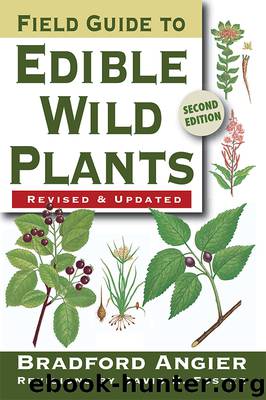Field Guide to Edible Wild Plants by Bradford Angier

Author:Bradford Angier
Language: eng
Format: epub
ISBN: 9780811744049
Publisher: Stackpole Books
Published: 2013-04-16T16:00:00+00:00
MINT
Mentha
FAMILY: Mint (Lamiaceae)
OTHER NAMES: Spearmint, Oswego Tea, Beebalm, Lemon Mint, Wild Bergamot, Horsemint, Peppermint, Pennyroyal, American Pennyroyal, Mountain Pennyroyal, Western Pennyroyal, Lamb Mint, Fieldmint, Brandy Mint, Watermint, Wild Mint, Horehound, American Mint, Giant Hyssop.
DESCRIPTION: The various wild mints—important to us from ancient times to the present as foods, scents, flavorings, medicines, and the like—are numerous and widespread but, fortunately, easy as a whole to recognize because of their square stems, opposite leaves, and pleasantly familiar fragrance. This characteristic aroma may not be perceptibly in the air where just a few mints grow together, but you’ve only to rub a leaf between thumb and forefinger to smell it.
For instance, there is spearmint with its square stems, oblong or lance-head-shaped leaves growing opposite one another, and its odor that is so familiar to anyone who’s chewed gum. Growing from about 1 to 2 feet tall, this is a smooth green perennial whose creeping roots spread it rapidly through wet areas. Branched, it has odoriferous green leaves that are stemless or nearly so, a bright inch or two long, pointed, narrow based, and unevenly sawtoothed. Small, pinkish purple to white blossoms encircle a thronged spike at the top, which is usually set off at each lower side by a smaller flower cluster.
Peppermint grows similarly in the same sort of habitats, but has leaves that are somewhat shaggy beneath rather than smooth like the spearmint’s and that are different, too, in that their edges are uniformly indented. There is also the marked variance in scent.
Oswego tea, or beebalm as it is frequently called, blooms from June through August with distinctively large, showily beautiful lavender to scarlet flowers, usually bunched on unbranched stems, atop a 1- to 3-foot, square, branching stalk. The opposite, bright green, sawtooth-edged leaves are oval or shaped like lance heads. The plant as a whole is rather coarse, sharply pointed, and hairy.
DISTRIBUTION: The wild mints, many of which have escaped from cultivation, are widely distributed throughout the United States and the southern half of Canada, preferring damp ground.
Spearmint, to be more specific, is abundant in spots from British Columbia and the state of Washington to the Maritime Provinces, south to Florida and California.
Peppermint is common from the Maritimes to Manitoba, south to Florida and Louisiana, being scattered elsewhere. Oswego tea brightens the landscape particularly from British Columbia to Quebec, south to Tennessee and Arizona.
EDIBILITY: The mint family as a whole has glands filled with aromatic oil. This is so volatile, in fact, that much of it will be wasted if you try to extract it by boiling unless your purpose is to perfume the surroundings. Instead, immerse a handful or so of fresh mint leaves in hot water, cover, and leave to steep overnight. Then strain and use. This not only conserves a large part of the aroma, but it also saves the abundant vitamins A and C.
Another thrifty way to use fresh young mint leaves is finely chopped in green salads. You’ll want to do a bit of experimenting first, though, as there are considerable taste differences among various species.
Download
This site does not store any files on its server. We only index and link to content provided by other sites. Please contact the content providers to delete copyright contents if any and email us, we'll remove relevant links or contents immediately.
Sapiens: A Brief History of Humankind by Yuval Noah Harari(14244)
The Tidewater Tales by John Barth(12608)
Mastermind: How to Think Like Sherlock Holmes by Maria Konnikova(7221)
Do No Harm Stories of Life, Death and Brain Surgery by Henry Marsh(6887)
The Thirst by Nesbo Jo(6826)
Why We Sleep: Unlocking the Power of Sleep and Dreams by Matthew Walker(6618)
Life 3.0: Being Human in the Age of Artificial Intelligence by Tegmark Max(5474)
Sapiens by Yuval Noah Harari(5293)
The Longevity Diet by Valter Longo(5017)
The Body: A Guide for Occupants by Bill Bryson(4973)
The Rules Do Not Apply by Ariel Levy(4842)
The Immortal Life of Henrietta Lacks by Rebecca Skloot(4523)
Animal Frequency by Melissa Alvarez(4394)
Why We Sleep by Matthew Walker(4358)
The Hacking of the American Mind by Robert H. Lustig(4318)
Yoga Anatomy by Kaminoff Leslie(4303)
All Creatures Great and Small by James Herriot(4228)
Double Down (Diary of a Wimpy Kid Book 11) by Jeff Kinney(4204)
Barron's AP Biology by Goldberg M.S. Deborah T(4095)
